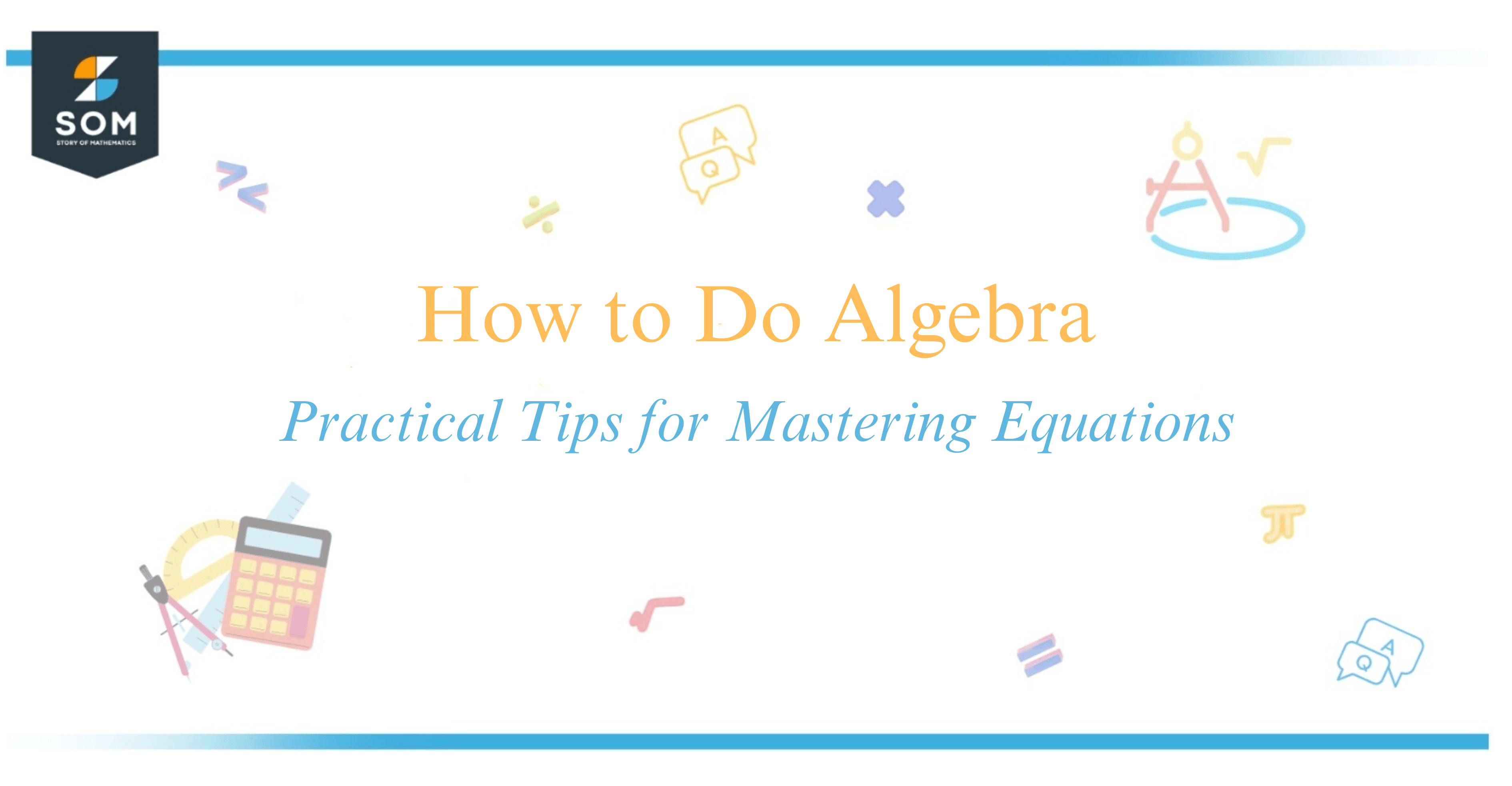JUMP TO TOPIC
 To do algebra, we should first strengthen our foundation in basic arithmetic operations, such as addition, subtraction, multiplication, and division. Understanding these core concepts is crucial because algebra builds upon them, introducing variables that represent numbers.
To do algebra, we should first strengthen our foundation in basic arithmetic operations, such as addition, subtraction, multiplication, and division. Understanding these core concepts is crucial because algebra builds upon them, introducing variables that represent numbers.
As we begin our journey in algebra, it’s essential to foster confidence along the way, which comes from practice and the realization that algebra is a set of tools that empowers us to solve a variety of problems.
We recognize that each algebraic equation is a puzzle waiting to be solved, and just like any puzzle, there’s a method to approach it. Familiarity with the order of operations, the ability to manipulate algebraic expressions, and knowing how to handle fractions and decimals are all part of our toolkit.
Let’s join forces and demystify algebra, turning it from a feared subject into one where we can excel through patience and persistence. Stay tuned as we explore practical tips that will help us maneuver through the world of algebra together.
Understanding the Basics of Algebra
When we approach algebra, we’re engaging with a branch of mathematics where symbols, often called variables, take the place of numbers. These variables can represent numbers whose values are not yet known, allowing us to solve a wide range of problems.
In algebra, it’s crucial to get comfortable with variables. Think of a variable like a placeholder for a number we’re trying to find. For example, in the equation x – 2 = 4, x is our variable.
Order of Operations
Remembering the order of operations is key to solving algebraic equations. We use the acronym PEMDAS to recall this sequence:
- Parentheses
- Exponents
- Multiplication and Division (from left to right)
- Addition and Subtraction (from left to right)
By sticking to this order, we ensure that we solve equations accurately.
Working with Equations
Equations are like puzzles where we aim to isolate the variable and find its value. Let’s break this down:
- Identify what’s being added, subtracted, multiplied, or divided to the variable.
- Perform the opposite operation on both sides of the equation.
- Simplify until the variable stands alone with its value revealed.
Here’s a simple table to illustrate these steps with the equation x + 3 = 7:
| Step | Equation | Operation | Result |
|---|---|---|---|
| 1 | x + 3 = 7 | Identify | x + 3 |
| 2 | x + 3 – 3 = 7 – 3 | Subtract 3 | x = 4 |
By applying these foundational concepts, we set ourselves up for success in solving algebraic problems. Remember, practice is our best friend in becoming proficient with algebra.
Solving Common Algebra Problems
When tackling algebra problems, our first step is always to understand the problem at hand. For linear equations, we often have to find the value of a variable that makes the equation true. Let’s look at an example:

Problem: Solve for x: 2x + 3 = 7
Solution: First, subtract 3 from both sides to get 2x = 4. Next, divide both sides by 2 to find x = 2.
The Quadratic equations can be a bit trickier. These involve terms squared (like x²) and often require finding two solutions.
Problem: Solve for x: x² – 5x + 6 = 0
Solution: We can factor this equation to (x – 2)(x – 3) = 0, which gives us the solutions x = 2 and x = 3.
Word problems add another layer of complexity because we must translate a narrative into an equation. Here’s a step-by-step approach:
- Define variables: Let x represent what we’re solving for.
- Set up an equation: Use the given information to form an equation.
- Solve the equation: Use algebraic methods to solve for x.
- Verify your answer: Check if the solution makes sense in the context of the problem.
To ensure we’re solving problems efficiently, we adhere to the following best practices:
- Check for understanding: Ensure we grasp all aspects of the problem.
- Organize information: Write down what we know and what we need to find out.
- Break it down: Tackle the problem in smaller, more manageable steps.
- Check your work: Always review solutions for potential errors.
By following these strategies, we’ll be equipped to handle most algebra problems that come our way!
Avoiding Mistakes and Building Confidence
When we approach algebra, understanding the common pitfalls is as important as learning the concepts themselves. We will identify a few frequent mistakes and share strategies to bolster your confidence in algebra.
Order of Operations: A frequent mistake is not following the PEMDAS/BODMAS rules, where you perform calculations in this order: Parentheses/Brackets, Exponents/Orders, Multiplication and Division (from left to right), and Addition and Subtraction (from left to right). Remembering this acronym helps us avoid computation errors.
Variables and Equations: It’s easy to misinterpret variables or simplify equations incorrectly. We should always double-check our work, ensuring that we combine like terms and distribute coefficients properly.
Quadratic Equations: Solving these can be tricky. Remember to apply formulas and the factoring techniques correctly. Incorrect application could lead to wrong solutions.
To enhance our confidence, we must practice regularly. Working on various problems increases our familiarity with the types of questions that may appear on algebra tests.
Self-Teaching Guide: Make use of guides and textbooks. These resources often contain practice exercises and clear explanations for solving different types of algebra problems.
Use Technology Wisely: Incorporate educational technology where appropriate. Software and online platforms can provide interactive lessons and exercises that adapt to our skill level.
Study Groups: Working with peers can clarify doubts and reinforce learning. If someone else understands a concept, they can help explain it from a student’s perspective.
Regular Review: Finally, revisiting past topics periodically can help cement our understanding and contribute to long-term retention of algebra concepts. This habit ensures we’re always prepared for upcoming exams.
By staying mindful of these tips, we elevate our algebra skills and approach tests with greater assurance.
Exploring Algebraic Operations
In algebra, understanding how to manipulate numbers and variables through basic operations is essential. We’ll guide you through each process step by step.

Addition and Subtraction
When we’re dealing with algebraic expressions, addition and subtraction are about combining like terms. Here’s how we do it:
- Identify like terms: These are terms with the same variable raised to the same power.
- Combine them: Add or subtract their coefficients.
Example: (3x + 2x = (3+2)x = 5x) ($7y^2 – 4y^2$ = $(7-4)y^2 = 3y^2)$
Multiplication and Division
For the multiplication of algebraic terms, we use the distributive property and laws of exponents.
- Distributive property: (a(b + c) = ab + ac)
- Multiplying exponents: When bases are the same, we add exponents. $(x^a \cdot x^b = x^{a+b})$
With division:
- Divide coefficients: If $( \frac{8x}{2x} )$, divide 8 by 2 to get 4.
- Subtract exponents: If $( \frac{x^3}{x^2} )$, subtract exponents (3 – 2 = 1), so our answer is $(x^1)$ or simply (x).
Working With Fractions and Decimals
In algebra, we often encounter fractions and decimals in equations:
For fractions:
- Find a common denominator for addition and subtraction.
- Multiply straight across the numerator and denominator for multiplication.
- Flip the second fraction and multiply for division (reciprocal).
Example: $( \frac{3}{4} + \frac{1}{4} = \frac{3+1}{4} = \frac{4}{4} = 1 ) ( \frac{1}{3} \cdot \frac{3}{4} = \frac{1 \cdot 3}{3 \cdot 4} = \frac{3}{12} = \frac{1}{4} )$
With decimals, line up the decimal points for addition and subtraction. For multiplication, multiply normally and count decimal places from right to left in the product equal to the sum of the decimal places in the factors.
Practice these operations to build a strong foundation in algebra. Remember, step by step, we can solve even the most complex algebraic expressions.
Graphs and Functions in Algebra
When we work with functions in algebra, we often represent them visually using graphs. Graphs make understanding and interpreting functions easier because they provide a picture of what’s going on.
Function Notation is how we write functions algebraically. For example, if we have a function f that takes an input x, we write it as f(x). This notation helps us quickly see how the output is connected to the input.
Function Transformations change the appearance of a graph. Here are the basic types:
| Transformation | Effect on Graph |
|---|---|
| Vertical Stretch | Make the graph taller |
| Horizontal Stretch | Make the graph wider |
| Reflection | Flip the graph over the x-axis or y-axis |
| Translation | Shift the graph up, down, left, or right |
To graph a function, we create a set of points where each point represents an input and its corresponding output. By connecting these points, we get the shape of the function, which helps us see patterns like linearity, curvature, and other important behaviors.
When interpreting functions, we look for specific characteristics like:
- The intercepts, where the graph crosses the axes.
- The slope, indicating steepness and direction for linear functions.
- The vertex for quadratic functions, which is the highest or lowest point.
Remember, different types of functions have different features, but once you master interpreting these features on graphs, you’ll gain a deeper understanding of how the function behaves across different values.
In short, familiarizing ourselves with graphing and interpreting functions equips us with the tools to tackle algebra problems more effectively.
Advanced Algebraic Concepts
In advanced algebra, we dive deeper into more sophisticated topics beyond the foundation we’ve built in basic algebra. To excel in these areas, it’s important to understand the following concepts:
Polynomials: We explore polynomials further by engaging with higher-degree equations and understanding the nuances of factoring polynomials. Factorization is key, allowing us to break down complex polynomials into simpler factors, which simplifies solving the equations.
Polynomial Example: $x^3$ - $2x^2$ + x - 2 Factored Form: (x - 1)($x^2$ - x + 2)Ratios and Proportion: We use ratios to compare two quantities and proportions to express that two ratios are equal. These are crucial when solving problems involving scale and in real-world applications such as in mixtures or map reading.
Inequalities: Expanding upon simple inequalities, we encounter systems of inequalities and learn to graph the solutions on a coordinate plane. We also explore absolute value inequalities which require careful attention as they introduce two potential ranges of solutions.
Factorials: Often represented with an exclamation point (n!), factorials are the product of all positive integers less than or equal to n. They are frequently found in permutations and combinations, which play a large role in probability and statistics.
Here’s a quick reference on how to denote various key elements:
- Absolute value: |x|
- Factorial of 5: 5!
- Polynomial factorization: ( (x – r_1)(x – r_2)…(x – r_n) ), where each ( r ) is a root.
By grasping these concepts, we prepare ourselves for tackling algebraic challenges with confidence. Remember, practice is vital, so work through problems, and don’t hesitate to seek help when needed. Happy solving!
Applications of Algebra
We encounter algebra in many situations, often without even realizing it! Here are a few practical tips on how we can apply algebra in our daily lives.
Budgeting: By creating equations to manage our incomes and expenses, we can keep our finances in check. It’s a practical application of solving for an unknown variable, our savings!
Cooking and Recipes: Altering a recipe? We use ratios and proportions, which are algebraic concepts, to adjust ingredient amounts whilst maintaining taste and consistency.
Shopping Discounts: Calculating discounts and sales prices is a day-to-day use of algebra. A price tag showing 20% off? No sweat, we just multiply the original price by 0.8 to find the new price.
When it comes to learning algebra, resources are plentiful:
Technology Tips: Websites like kastatic.org and kasandbox.org provide exercises and lessons to strengthen our algebra skills without the hassle of a web filter blocking our study. These resources usually load external resources so we can practice unblocked.
Programming: For those of us interested in technology, programming offers a direct connection to algebra. Understanding variables and logic in code requires algebraic thinking.
Projectile Motion: Sports enthusiasts use algebra intuitively when they calculate the best angle and force to throw a ball. It’s a real-world application of systems of equations!
If we need help, there’s a wealth of math lessons and exercises online that can assist us with our algebra studies. Remember, we’re not alone, and there are always more ways to make algebra both fun and relevant to our lives.
Conclusion
In our journey through algebra, we’ve equipped ourselves with an array of strategies to solve equations and understand mathematical expressions. We’ve learned that algebra is not just about finding the value of ‘x’, but about forming connections and developing problem-solving skills that are applicable far beyond the classroom.
Let’s recap the key takeaways:
- Practice regularly: Just like learning a new language, proficiency in algebra comes from consistent practice.
- Build from basics: Ensure your foundational math skills are solid, as they are the bedrock on which algebra stands.
- Understand the principles: Grasping the concepts behind the formulas makes it easier to apply them to different problems.
- Seek help when needed: Don’t hesitate to ask for assistance or use additional resources if concepts are unclear.
Remember, every equation represents a problem that can be dissected and conquered. By now, we should be better at identifying how algebra relates to real-world situations, which improves our analytical thinking.
As we continue to apply these skills in everyday scenarios, the versatility of algebra becomes increasingly clear. Whether budgeting finances, adjusting recipes or analyzing data, the power of algebra enhances our decision-making abilities and helps us approach complex problems with confidence.
